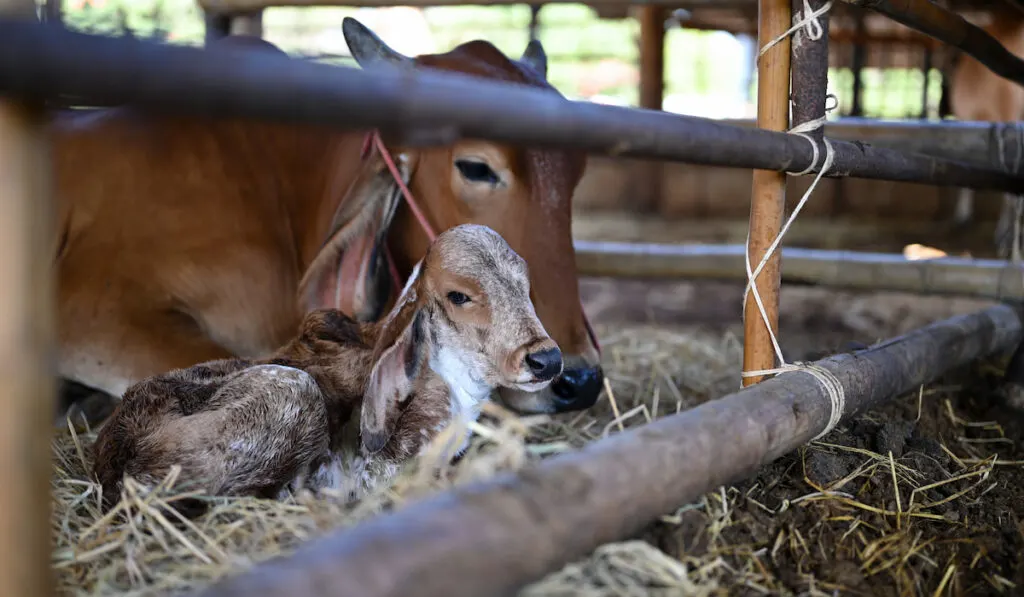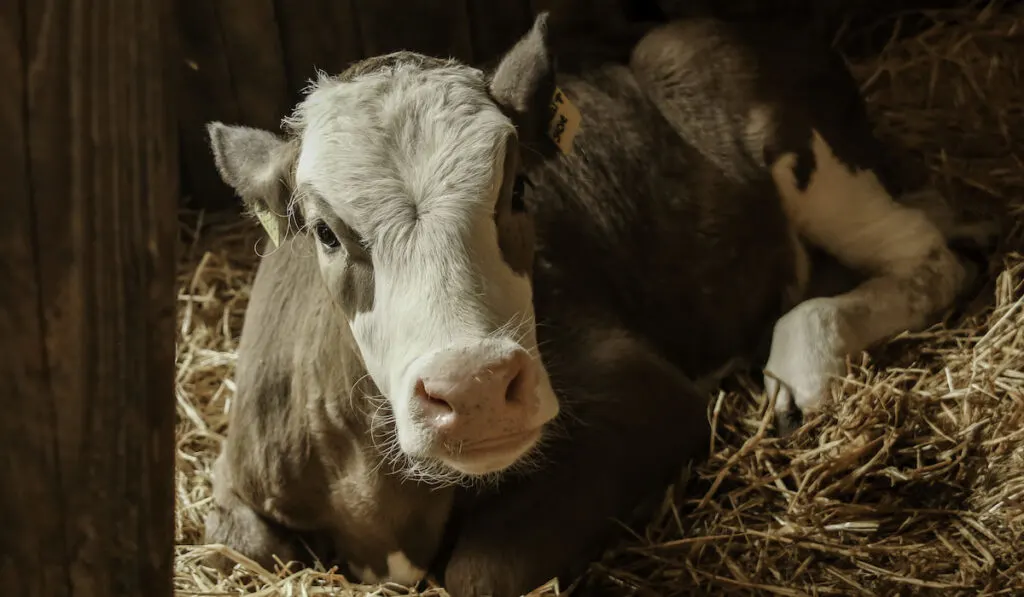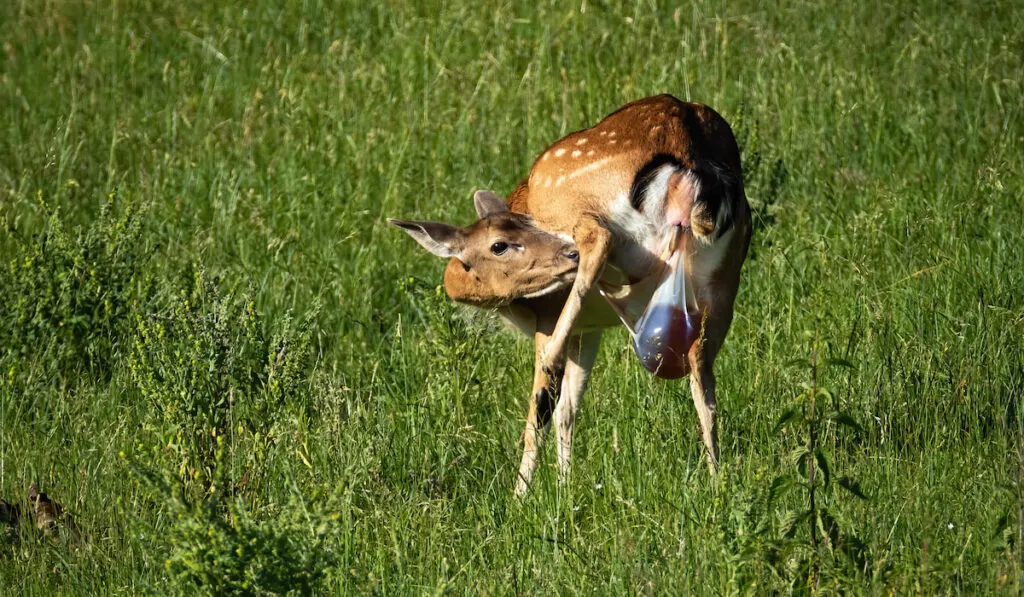The afterbirth, commonly called the placenta, is a mass of tissue seen in pregnant placental mammals. It connects the fetus to the mother for the gestation period. So, when pregnant mammals finally give birth, the placenta is also delivered.

Cows are placental mammals. So, it is no surprise that they bring forth a placenta while calving. Like in many other placental animals, you may find a cow eating their afterbirth. This act is called placentophagia.
Table of Contents
Should a Cow Eat the Afterbirth?
So, should a cow eat the afterbirth?
It is OK for a cow to eat the afterbirth if she wants to. So far, there’s no concrete reason as to why cows carry out the act of placentophagia. It might be due to general hunger or a specific craving for the placenta. It might also be a defense mechanism to keep away predators.
No matter what the reason might be, there seem to be little or no negative issues resulting from cows eating placenta.
Is there more to know about placentophagia? Yes, there is. This article will discuss the functions of the placenta, what the placenta is made of, and much more.
The Purpose of the Placenta
Cow fetuses start receiving nutrition immediately after they are conceived. It’s the only way for them to grow. When you feed a pregnant cow, both the fetus and the mother gets the food.
Since the fetus does not have functional organs at this stage, how does it get food from its mother? The answer is the placenta.
The placenta serves as the medium through which the fetus gets nutrients from the food consumed by the mother cow.
Besides serving as a medium for nourishment, what else does the placenta do?
- It serves as the lungs of the fetus. The placenta receives oxygen for the fetus and directs carbon dioxide out.
- It functions to remove toxic waste from the fetus.
- It detoxifies and filters the substances coming in and going out of the fetus.
- The fetus is quite delicate and needs to be protected even when inside the cow’s womb. The placenta produces a fluid that surrounds the fetus to provide some protection.
- It also regulates the temperature of the fetal environment to a level slightly warmer than the cow’s internal temperature.
- It produces various hormones needed for the development and survival of the fetus.
- It serves as the means of attaching the fetus to the womb of the cow.
What Is the Placenta Made of?
The placenta is formed from a combination of tissue from the calf and tissue from the cow. These tissues are the decidua and the chorion.
The chorion is derived from the embryo of the calf while the decidua is from the cow’s endometrium. The placenta passes through the umbilical cord as it connects from the cow to the fetus.
The umbilical cord contains veins and arteries that branch out over the placenta and form a thin layer of cells. This structure of the blood vessels over the placenta facilitates fetal respiration.
How Long Does It Take a Cow to Deliver the Placenta?
After calving, it takes a cow some minutes to a few hours before the placenta is delivered. You should wait between 30 minutes and 12 hours before you can conclude that the cow has a retained placenta (their placenta is stuck inside their womb).
If the placenta does not drop out within 12 hours, you may wait 12-14 days for it to drop spontaneously. However, one thing you should monitor when the cow has retained placenta is its temperature.
If the cow’s temperature is elevated (>103 °F), you should start suspecting an infection. A retained placenta can become infected inside the cow and cause a fever.
If you notice this, you should inform a veterinarian so a diagnosis can be made and an antibiotic can be administered to the cow.
Never try to remove or force out the placenta from the cow. If you do this, the cow’s cycle will take longer to normalize, and its first conception rate will reduce.

Having retained placenta is usually indicative of an underlying health problem in the cow. Such problems are obstructed labor (dystocia) and milk fever. Infections such as leptospirosis and bovine viral disease can also cause retained placenta and premature calving.
In some other cases, retained placenta may be caused by deficiencies in vitamins and minerals. Low levels of vitamin A, vitamin E, and selenium can leave your cow at risk of retained placenta.
How Do You Know if the Cow Ate the Placenta or Retained It?
After calving, if you do not see the placenta, there are 2 main possibilities: the cow ate the placenta, or it has a retained placenta.
The most common sign you’ll see when the cow has a retained placenta is a rotten, discolored membrane drooping from its vulva. In some cases, you may not see this membrane, but you will notice a terrible fetid discharge from the cow.
If you do not see the signs of a retained placenta, and you do not see the placenta, you can most likely conclude that the cow has eaten it.
Possible Side Effects of Eating Placenta
In most cases, no side effect has been reported from cows eating placenta. At the same time, there has been limited research on this topic.
However, the following are some side effects that could happen if a cow eats a placenta:
- Choking
- Digestive problems
- Increased feed intake
FAQ on Placenta Eating (AKA Placentophagy)
Which animals do not eat placenta?
Most placental mammals eat the placenta after giving birth. But, aquatic mammals and most humans do not.
Is it healthy for animals to eat placenta?

There are no studies to confirm whether placenta is nutritious or not. However, some people believe it is healthy and nutritious.
Does animal placenta smell?
Yes, animal placenta smells. A freshly delivered placenta will have fresh blood on it, so you can expect it to smell as such. But when the placenta starts to rot, the smell will become unpleasant.
Is placentophagy cannibalism?
There is currently no consensus about the status of placentophagy as cannibalism. But there have been cases where mother rabbits accidentally eat the baby rabbits while consuming the placenta.
Does placentophagy help with pain?
So far, many of the proposed benefits of placentophagy have not been confirmed. But one hypothesis suggests that the placenta contains substances that can help with post-parturition pain.
Final Thoughts
Cows should eat afterbirth if they want to. This act is relatively harmless and potentially beneficial. So, since there are a lot of potential gains and seemingly nothing to lose, why not?
Resources
- http://www.animal-science.org/content/68/12/4267
- https://study.com/academy/lesson/the-placenta-and-the-fetus-structure-and-function.html
- https://heiferinyourtank.typepad.com/theres_a_heifer_in_your_t/2011/08/a-little-afterbirth-snack.html
- https://www.drovers.com/article/dealing-retained-placenta
- http://thecattlesite.com/diseaseinfo/232/retained-placenta/
- https://farmfitliving.com/cow-eating-her-placenta/
